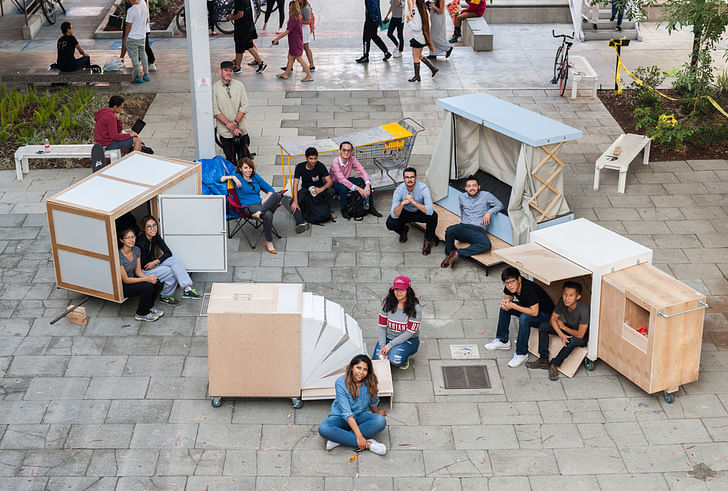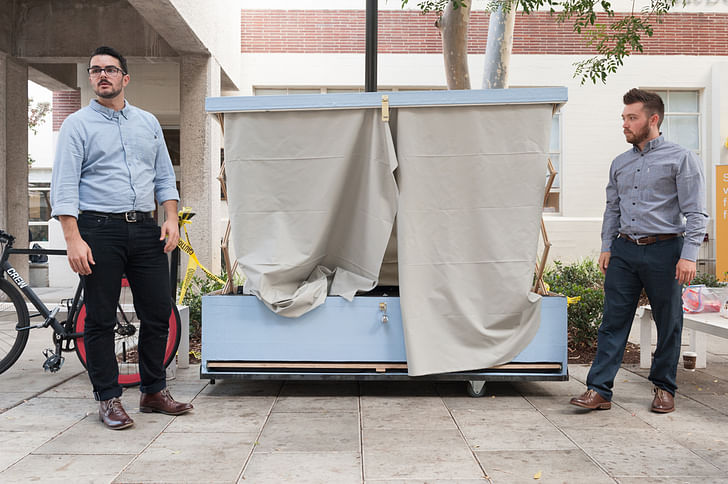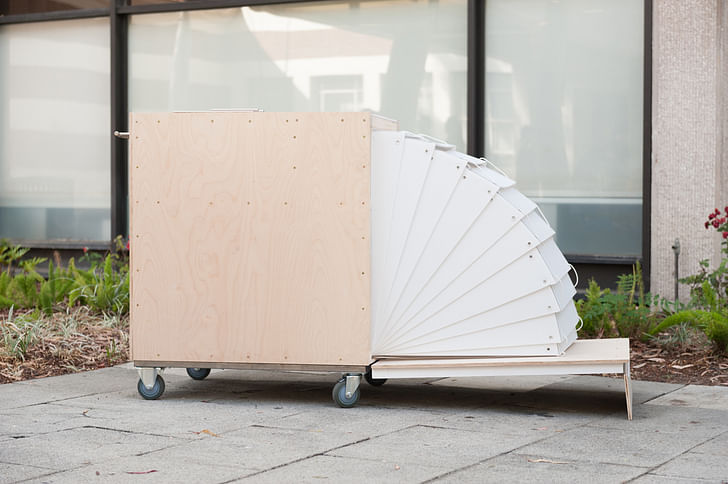

Just a few miles from the University of Southern California campus, Skid Row contains a significant portion of the homeless population of Los Angeles, a city in the midst of a declared state of emergency with nearly 47,000 people in total living in shelters and on the street. For R. Scott Mitchell and Sofia Borges, two instructors at the USC School of Architecture, this city-wide crisis demands an architectural response. “The homeless are always thinking about architecture. It's time we started thinking about them,” they wrote in the syllabus for their course, Homeless Studio.
The Homeless Studio was divided into two parts: a short charette on nomadic structures, followed by a fabrication workshop. During the first part, the students were tasked with developing a nomadic sleeping space around the size of a shopping cart, with a budget of just $500 for the entire project. For the second part, the students designed tiny homes entirely out of materials they scavenged, with the ultimate aim of redistributing them to homeless people. Finally, the students worked with a real-world client—the Hope of the Valley Rescue Mission—to design and build a 30-bed by-right shelter for senior women.
“[Hope of the Valley Rescue Mission] CEO Ken Craft has become our client for the semester and we have been working closely with him, the Departments of Building and Safety, City Planning, and now the Mayor's Office, to develop a city-supported modular, adaptable housing solution for immediate stabilization to get people off the streets until they can be placed in permanent supportive housing,” Borges explains.
We got in touch with Mitchell via email to hear more about how the studio worked and the impetus for it.

Homelessness is typically understood as a problem that pertains more to policy and government than architectural design. What was the initial motivation for the studio and what is it trying to achieve?
It’s true that the problem is deeply rooted in policy and governmental issues. However, the situation in Los Angeles is compounded by the housing market and increasing population density. These added conditions fall into an area that architects are well equipped to handle. It’s doubtful that policy or architecture alone could do anything to directly alleviate the problem. Working together it seems that some positive steps are possible. The initial motivation for the studio came from the founders of Madworkshop, Mary and David Martin. Madworkshop reached out to USC School of Architecture with the hope that the students would be able to come up with some practical, creative and buildable solutions of homelessness in Los Angeles.The concept is to get folks off the street and into a safe and secure shelter as rapidly as possible.
What were the parameters of the prompt?
The prompt was somewhat open initially. It was always housing, but we knew that it had to be something that could be accomplished in a very short design timeframe. The idea of emergency stabilization came up in our early conversations and it just continued from there. The concept is to get folks off the street and into a safe and secure shelter as rapidly as possible.


These days architecture students rarely design anything that will actually be built. Did you find that students adapted well to the challenges of designing a building that is intended to be realized as a home?
Yes, they adapted quickly. We were actually stunned at how fast they came up to speed. Bear in mind that these are 4th year students just coming out of three years of a set architectural curriculum. They were ready to be unleashed, so to speak, on a real world project. It might have been a relief to step away from the computer for a minute and build something. The idea of designing a “home” was never an issue as we were very clear about the client’s needs. They took to it quite readily. The motivation for this was to make them consider the idea of found materials and how people living on the street had to think about construction and shelter.
Likewise, most students design without material limitations in mind. Can you tell us a bit about the motivation to employ only salvaged materials? And the students response to this stipulation?
Actually, this part needs some minor clarification. Before the final assignment the student groups worked on two initial homeless typological studies. The first was a secure nomadic sleeping unit roughly based on the volume of a shopping cart. They had a material budget of $500 for the entire project. The second study was a tiny homes project. This was the exercise that employed only salvaged materials. The students scavenged for a weekend and spent the following four days building the small structures from their finds. Our only real expenditure was on casters, locks and fasteners. The motivation for this was to make them consider the idea of found materials and how people living on the street had to think about construction and shelter. They appeared to take the transition from new to found materials in stride. However, seeing that they only had a week to complete the built project they might not have had time to think about how difficult it might be. The final output of the course has been a much larger step for the students as the client and the city are now fully involved in the design process.

Could you tell us a bit about a few of your favorite projects that came out of the course?
It may sound diplomatic on my part, but I don’t think we’ve really chosen a favorite. The work they’ve been able to generate in the last twelve weeks has been incredible. I’ll admit that I look back on the first assignment as my technical favorite. Still amazed by how inventive they were with the nomadic shelters.
As in all architecture, the question of liability keeps coming up. What are some of the challenges you've encountered trying to get these structures in use?
As in all architecture, the question of liability keeps coming up. We’ve had to be careful about how the units are distributed. It’s become more or less a blind system in that we’ve had to sign them over to a third party for distribution. The third-party, artist Gregory Kloehn, led the week-long building workshop that generated the tiny homes. All we can say is that they are out in world and serving their intended use.
What do you see as the future of the program?
There has been some internal discussion of us continuing with similar work in the fall of next year. The feedback has been great and the student interest is definitely there. Hopefully the funding will be.

Writer and fake architect, among other feints. Principal at Adjustments Agency. Co-founder of Encyclopedia Inc. Get in touch: nicholas@archinect.com
11 Comments
I'm looking for some UCLA structural engineering students to participate in an experimental project aimed at homeless veterans. I will be building a test BergyBox in Hollywood. UCLA owes a debt the the West LA Veteran's campus and should be up for this.
Homelessness isn't a design problem. It's a national tradgedy, and it needs to be met with real solutions: housing and services for those in need. We have the means to fix the problem, we just lack the compassion and political will to do so. Shame on us.
But, hey, here's a splintery plywood box to drag around. Cute!
How could Archinect print this article? Really?!? To end homelessness we need to get them off the street. Not build prettier cardboard boxes. Maybe we need to make political science a pre-req to "homeless studio"
Show me a structure that includes water, an incinolet toilet and a cooking surface and I will consider your project viable. Otherwise, you might as well toss a bunch of coffins out onto the sidewalk and you will have achieved the same results as what these future designers have.
Architecture requires completeness of thought and attention to all needs and details.
This kind of project exploits a naive architectural stance, in the same manner that to someone with a hammer, everything looks like a nail, so it is that to an architect every problem’s solution is a building. Architects are educated to be creative problem solvers in the context of complex systems and the profession will only begin to breach the wall of its insularity when the architectural intelligence is allowed to, if not encouraged to, engage problems where the solution is truly unknown, i.e., to facilitate a truly creative process. If the problem is defined as a building, the solution is guaranteed to be a building. There’s no reason architects can’t be problem-solving process experts, whether generally or informed by specific self-interested learning (e.g., political science), and seek a chair at the table as such (watch out “design thinking” proponents). (I know most will be satisfied to design buildings and nothing more, but the potential exists for an expanded definition of what architects are capable of.)
Anybody seen Zero Dark Thirty? Don't these all remind you of the wood box we used to torture suspected Al Qaeda militants?
Yep, while you all debate the poly-sci, the seats at the table, policy decisions, etc. People that are homeless, are homeless for a reason, and many of the homeless are homeless by choice. While most of these designs are crap, in fact the only one I like is the shopping cart, these students are thinking tactically to deal with the situation on the ground, now. That's like saying well, the solutions to dealing with hurricanes hitting Haiti, is to deal with global climate change, well duh, but right now, Haiti was just hit by a category 5 and people need help now. That doesn't mean you don't press for solving the larger problem, strategically, as many of you noted, we have the skills to solve bigger problems, in short; we can walk and chew gum at the same time.
Cut em a break.
@b3tadine[sutures] - To teach and then laud our students for coming up with only partial solutions and not striving to consider and achieve the whole is, in my opinion, a disservice to the students.
As for Haiti, and equally as much, mostly all structures east of the Mississippi, the feasibility to construct buildings to withstand foreseeable conditions and circumstances exist (concrete slabs and CMU walls without rebar or solid grouting for example. Come on. Really?). It is the fault of local building codes not being composed to require such structures be built. And it is professionally irresponsible not to do so. The 'they cost too much to build' line doesn't fly as someone has to come up with the funds to demo the remains and rebuild- be it insurance companies (higher premiums for everyone), FEMA (your tax dollars), the property owners or all the bleeding heart dollars that get thrown (and often squandered/pilfered) in. Let us not leave out the waste of resources and pollution created by the fallen remains. All products of shortsighted human thought, carelessness, and recklessness.
So, all mental, psychological and/or social issues that cause an individual to be homeless aside, if I am out there in the elements and you sincerely wish to provide me a solution, no matter how permanent or temporary, then give me the ability to take a crap, wash my hands and face and pull together a hot meal as well as lie my head down to rest.
A simple code of ethics to live and work (and teach your students) by- 'Do it right, or don't bother'.
"Cut[ting} em a break" in architecture leads to death and destruction. The sooner students learn this, the better and more successful they will be as architects, designers, and engineers.
Right. I'm sure that works on the ground, "do it right, or don't bother". You seem to forget, the "both/and..." solution. You seem to be suggesting, by your "DIRODB" method, that the people, and government of Haiti have a choice; build your structures using the most expensive construction methods, or move off the island. I mean, "do it right, or don't bother", right? And, are you going to be the one imposing IBC 2015 on the people of Haiti?
As for the ability to take a crap, or shower, the most responsible thing we can do, as tax paying citizens, is to provide basic bath houses for those that are homeless, like Here, and Here.
And please, stop with the bull around "death and destruction" most architecture students, or architects, don't deal with death and destruction, that kind of hyperbole is unnecessary. You seem to miss my point altogether; dealing with homelessness is a manifold process, not just a one size fits all proposition, that kind of thinking is dangerous. We need to deal with the immediacy of the problem = tactically, and engage the larger forces over the long term to create change, that will take a generation to happen = strategically.
Another thing, the design brief, as stated seems to be this;
"The idea of emergency stabilization came up in our early conversations and it just continued from there. The concept is to get folks off the street and into a safe and secure shelter as rapidly as possible." [tactically]
and
Homelessness is typically understood as a problem that pertains more to policy and government than architectural design. What was the initial motivation for the studio and what is it trying to achieve?
It’s true that the problem is deeply rooted in policy and governmental issues. [strategically] However, the situation in Los Angeles is compounded by the housing market and increasing population density. These added conditions fall into an area that architects are well equipped to handle. It’s doubtful that policy or architecture alone could do anything to directly alleviate the problem. Working together it seems that some positive steps are possible. The initial motivation for the studio came from the founders of Madworkshop, Mary and David Martin. Madworkshop reached out to USC School of Architecture with the hope that the students would be able to come up with some practical, creative and buildable solutions of homelessness in Los Angeles.
. ..
Architecture students: please try to design something more efficient, weatherproof, comfortable, nomadic, light weight, affordable, private and protective than.., a tent.. Listen to the homeless and learn from them. Don't stop with this project but keep going. Who knows where it will take you? You must look at the city. I am optimistic you would figure and design it.
Block this user
Are you sure you want to block this user and hide all related comments throughout the site?
Archinect
This is your first comment on Archinect. Your comment will be visible once approved.